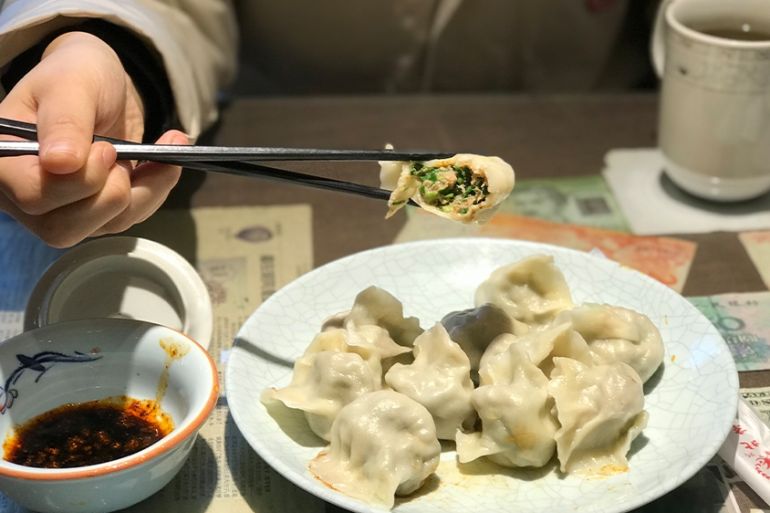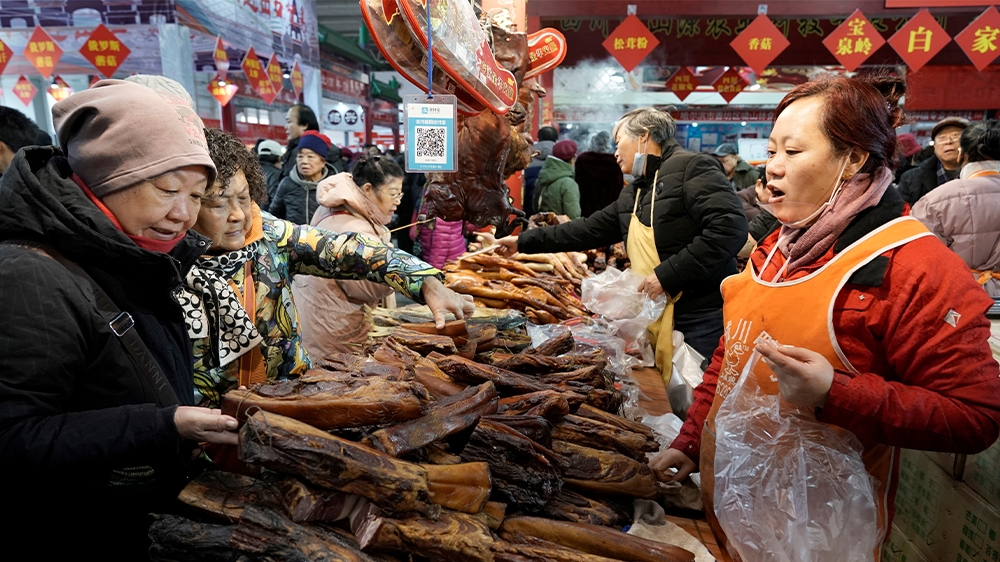Hogging plates: China’s diners still want pork despite price rise
Pork prices have doubled in China, but that won’t stop families enjoying the traditional dumplings on Lunar New Year.

Beijing, China – On Lunar New Year’s eve, families across China will gather for a lavish dinner of foods with symbolic meanings: noodles to bring longevity, fish for good fortune, peaches to ensure fertility, and red fruit such as apples and tangerines for good luck.
Reigning supreme, requiring the most labour and sure to bring unmatched comfort and joy, will be the dumplings.
Keep reading
list of 4 itemsNearly 55 million face hunger in West and Central Africa, UN warns
Revisiting molokhia amid war and displacement in Gaza
The iftar hotspot in New Delhi – launched by a citizenship law protest
Many Chinese families come together to fold dumplings on the eve of the holiday, which falls on Saturday this year. Dumplings are traditionally eaten between midnight and 2am and in the following days, reheated. They come in many varieties, depending on the region: boiled dumplings (jiaozi) are popular in the north, while southerners prefer steamed buns (baozi).
But regardless of how they are cooked, the filling of choice for dumplings is pork – mixed with cabbage, chives or celery for jiaozi, or stewed in a sweet sauce for baozi.
This year’s celebrations come on the heels of an outbreak of African swine fever that has wiped out half of China’s pig population and sent pork prices skyrocketing.
The government has scrambled to release pork from its national reserves and boost imports to keep the price stable, but pork is still twice as expensive – on average – as it was a year ago.
The cost has done little to curb people’s appetite for the meat, however.

While interest in poultry, beef and lamb has grown in recent years, pork is still the mainstay of Chinese cuisine, accounting for half of household meat consumption, wrote Cui Ernan, an analyst at the Beijing-based firm Gavekal, and nowhere is this more clear than during the Lunar New Year.
‘Precious childhood memory’
Pigs have been central to Chinese households because they thrive in the country’s climate and are relatively easy to look after. During China’s economic rise in recent decades, which included periods of famine in the 1950s and 60s, pork was more accessible than other types of meat.
“When we were children, most Chinese families were poor,” said Li Shuang, a 26-year-old graduate student at Renmin University in Beijing. “We were excited about the Spring Festival [which includes the Lunar New Year] because we could eat pork. So pork and dumplings remain a precious childhood memory.”
Pork also represents the epitome of Lunar New Year feasts. In south China, a lavish treat for the holidays is the “golden pig”, a pig covered with a sugar glaze with red colouring made of hawthorn fruit to symbolise wealth, said Gene Anderson, an anthropology professor emeritus at the University of California, Riverside, and author of The Food of China, a book about historic Chinese government food policies.
“Pork has always been the preferred sacrifice meat because it was special, available, and impressive,” Anderson said.

African swine fever has been devastating China’s pig population and its farmers since August 2018. The virus, which is harmless to humans but deadly to pigs, spread quickly because farmers and local officials were initially reluctant to report the disease. As many as half of China’s pigs, an estimated 300 million animals, have since died or been culled to prevent the disease from spreading.
At Beijing’s renowned Sanyuanli Market, pork prices in the week leading to the Lunar New Year appeared to have stabilised after peaking at the end of 2019. Pork leg was selling for 30 yuan ($4.30) per 500 grammes, while tenderloin was on sale for 38 yuan ($5.50) per 500 grammes. Around the same time last year, pork leg cost 14 yuan per 500 grammes, according to a butcher who gave only her surname, Feng.
Despite the increase in prices, business seemed to be going well. Shoppers lined up to buy various cuts of meat. Pork sales usually double around the Lunar New Year, said An Lihong, a butcher hailing from the northwestern province of Gansu who said she has sold pork at Sanyuanli for 23 years.
“Consumers are affected by the price difference, but for the festival, people will still shop,” An said. “They may buy chicken instead of pork during regular times, but for the festival, they will definitely buy pork.”
‘A festival feeling’
Shoppers seemed unbothered by the rise in prices of the staple meat. Gao Ke, a 63-year-old television producer, said he simply did not care about the price. He was buying pork to make his favourite dumplings, with pork and celery.
“You cannot make dumplings with chicken, lamb or beef. It doesn’t taste as good,” he said.

Some families will choose to skip folding dumplings and eat at a restaurant instead on Lunar New Year, but pork will still be top of the menu.
Most restaurants have so far absorbed the rising cost and not passed on the extra to their customers, said Shi Xinzhong, the owner of Mr Shi’s Dumplings restaurant in Beijing.
Shi said he has not raised prices since 2008, when he opened his first restaurant. A portion of pork and chives dumplings – Shi’s favourite when he was a child – costs 25 yuan ($3.60). Shi said he was expecting pork prices to stabilise by spring, at which point he might raise the dumplings’ prices.
The 53-year-old entrepreneur remembers that when people were poorer, they still found ways to enjoy the popular dish. When Shi was a child, his family used to make dumplings out of sweet potato flour, which was dark-coloured. The memory of his mother making the dumplings and of his own excitement about eating them puts a smile on his face.
“People make dumplings at happy and lucky moments,” Shi said. “It’s a festival feeling.”
Qu Chaonan contributed to this report